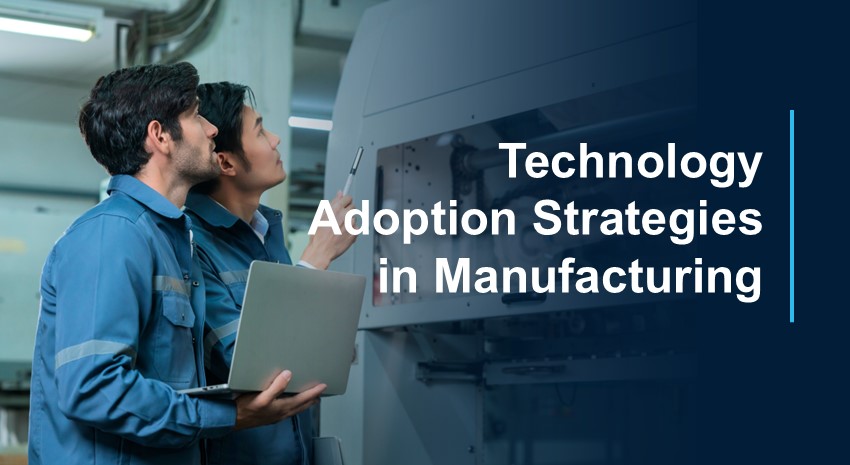8 Winning Strategies for Technology Adoption Among High-Performing Manufacturers

Technology is a fundamental enabler of agility and growth. Yet adopting new technologies in manufacturing remains a difficult journey. Pressures from global competition, shifting labor dynamics, rising costs, and increasingly complex supply chains are forcing manufacturers to rethink whether to introduce new technology into their companies.
Resistance to change, moving off old legacy systems, gaps in skills, and uncertainty around ROI can all slow progress toward adopting new technologies. So how do manufacturers not just embrace technology but do it successfully?
Here are eight winning strategies high-performing manufacturers use to accelerate adoption and make technology work for their businesses.
Start with the problem, not the tool
The most successful digital transformations don’t begin with technology; they begin with a problem worth solving. Whether it’s reducing production downtime, improving quality, addressing a labor shortage, or enabling better decision-making, every investment should be directly tied to a clear business objective.
Too often, manufacturers are tempted to pursue flashy innovations like AI or IoT because competitors are doing it or it seems like the next big thing. But if a solution doesn’t address a specific challenge, it risks becoming a distraction. Before evaluating any new tool or platform, manufacturers should map out pain points across their value chain and identify where technology can offer a meaningful impact.
Build from the bottom up
Technology implementation is as much about people as it is about platforms. A top-down directive to “go digital” may launch a project, but the people on the factory floor ultimately determine whether it succeeds.
Manufacturers that involve employees early in the process, especially those using the technology daily, are more likely to achieve sustainable adoption. Encourage collaboration between IT, operations, and production teams. Invite shop floor workers to offer feedback, test new systems, and suggest improvements. When employees feel heard and see how technology makes their jobs easier or safer, resistance fades, and engagement rises.
Don’t just train employees to use the system; help employees learn new skills
One of the biggest challenges in adopting technology is the skills gap. Many legacy employees who are experts in manual systems might be uncomfortable with digital tools. On the other hand, newer employees may be tech-savvy but lack domain knowledge.
The answer is not just training employees on how to use a system but investing in equipping your employees with the skills needed to use new technologies effectively.
Manufacturers are using microlearning platforms, real-time simulations, and AI-powered training assistants to meet employees where they are. The goal is to build confidence so that employees become drivers of innovation, not barriers to it.
Focus on integration and simplicity
Many manufacturing environments are a patchwork of legacy systems, siloed data, and disconnected processes. Simply layering new technology on top of existing problems can lead to more confusion, not less.
Instead, look for technologies that integrate well with your existing infrastructure. Rather than automating a broken process, identify and replace outdated systems and processes causing bottlenecks with modern, cloud-based systems that make it easier to integrate with other systems, eliminate redundancies, and improve data visibility.
Simplicity also matters to the user. If a system is too complex or cumbersome, adoption will stall. Invest in intuitive interfaces and mobile tools that support employees in real-time, whether they’re on the floor, in the field, or at a workstation.
Measure, learn, and iterate
Adopting new technology is rarely a one-and-done event. It’s a process of continuous improvement, experimentation, and learning. Manufacturers should define clear metrics for success from the beginning, such as improved throughput, reduced waste, faster order fulfillment, or higher customer satisfaction.
Start small with pilot projects, learn what works, and scale up based on results. Create feedback loops where frontline users can share their experiences and suggest refinements. And be ready to pivot if something isn’t working.
Make change management a priority
Even the best technology can fail if change management is overlooked. Employees need to understand not just what is changing but why. Transparency, communication, and leadership buy-in are essential.
Manufacturers should invest in internal communications that explain the benefits of new technologies in human terms, such as reducing repetitive tasks, improving safety, or creating opportunities for advancement. They should also recognize early adopters, celebrate milestones, and create a culture that views change as an opportunity rather than a threat.
Prioritize security
Adopting new technologies also means ensuring that sensitive information and intellectual property are kept out of the prying eyes of bad actors. Ensure any technology brought into the manufacturing process has built-in, auditable security, including access controls and interfaces.
Stay strategic and deliver value
Finally, remember that technology is a means to an end. The goal is not to become a “digital manufacturer” for its own sake but to build a business that is more responsive, efficient, and capable of delivering value to customers and employees alike.
That means always staying focused on the human element. Empower your workforce. Support creativity and problem-solving. Treat your technology investments not as isolated IT projects but as strategic initiatives that touch every part of the organization.
Need help choosing the right technology?
For manufacturers, technology adoption is no longer optional. But it’s not just about buying the latest tools. Rather, it’s about aligning those tools with business goals, empowering people, and building a culture that embraces change.
Start small, engage with stakeholders, and address potential challenges proactively.
Contact ArcherPoint by Cherry Bekaert if you need help deciding on the right technology to help your manufacturing business thrive.
